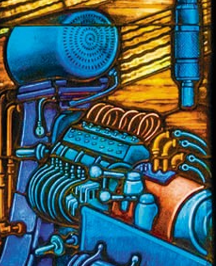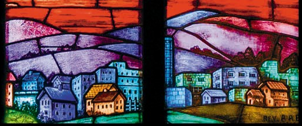
To commemorate the 150th Anniversary of the founding of Holyoke, St. Jerome Parish offers a limited-edition reproduction of the unique Holyoke Stained Glass window, commissioned in
1955 for the Golden Jubilee of the then Immaculate Conception Church – now the Immaculate Conception Chapel. St. Jerome’s Parish merged with Immaculate Conception Church in 2019.
The original piece is behind the altar at the Chapel, 54 North Summer Street in Holyoke. This is a work of sacred art, befitting a Catholic Church. At the center of the piece is the image of Jesus, whose halo radiates throughout the upper panels, flanked by the seals of the Pope & the Bishop of Springfield at panels #1 & #7. The lower right corner is marked “Rev AAB 1955” recognizing Pastor Rev. Arthur A. Brodeur, M.S. the LaSalette priest who commissioned the work.

The window is 14’ tall and 21’ wide. It consists of seven sections each 2’ wide. The base of the window is an artist’s representation of Holyoke. In the scene there are three church steeples once visible on the Holyoke Landscape: #1 – Precious Blood, #2 – Holy Rosary and #3 – Our Lady of the Cross.

In Panel #2, near the top is a micrometer, an industrial tool used to measure the thickness of very small items like thread and paper sheets. Though the knowledge to cut the thread has been around for a long time, a system of cutting the thread with consistent accuracy was developed here in Holyoke. Also, in this panel are two aluminum cylinders. Used in the making of paper, they put a high gloss finish on rag paper and in the making of fine writing paper. This system was developed in Holyoke’s heyday when about 72% of the world’s paper supply was produced here. A blue light represents the invention of light sensitive paper used in the making of “Blue Prints”.


In Panel #3 at the top of a machine is a symbol with wavy lines. This represents the symbol on the old Parsons Union Hall on Race Street. It was the first logo of the Paper Handler’s Association – a forerunner of the Unions. The first organized factory workers were here in Holyoke. Also in panel #3 you can see the old drive belts which operated the mills during the early years. Near the bottom of panel #3 is what appears to be an old oil can. This represents a system of self-oiling devices which later became industry standards.


Holyoke, with nearly 50 paper mills, became the world’s largest center for papermaking. Additionally, the city was home to the largest paper millwright firm in the United States, D. H. & A. B. Tower. At one time their firm was the largest designer of paper mills in the United States. Because of its prominence in industrial papermaking, Holyoke’s machinery and labor practices would be the subject of extensive study by officials and industrialists of Asia & South America, who sought to modernize their production methods.
Holyoke’s major contribution to industrial research & development was the Holyoke Testing Flume. This hydraulic testing laboratory and apparatus in Holyoke, Massachusetts, operated by the Holyoke Water Power Company from 1870 to 1932, tested the performance of water turbine designs, completing 3,176 tests of efficiency in that time. It was described by Robert E. Horton in court testimony as the only facility of its kind in the 19th and early 20th century, which made possible the standardization of American water turbines. This facility was adjacent to the Holyoke Dam.

Mt Tom and Mt Holyoke Ranges
At the base of Panels #6 & #7 are the artist’s rendition of the Mount Tom & Mount Holyoke Ranges, highlighting the impressive landscape and natural environment Holyoke residents have always treasured.
Panel #6 shows the dam. The dam is one of the most noted American engineering accomplishments of the 19th Century – the second dam; the first one collapsed immediately after its completion. Power lines are represented, emerging from generators later installed at the dam. Cheap electricity and a large work force allowed Holyoke to grow and prosper. The Holyoke Dam is to this day one of the major sources of carbon free electricity in the Northeast.

The Holyoke Dam

Paper & Textiles
Panel #5, is another paper making machine, however on the floor near the machine is a roll of cloth. This is to remind us that Holyoke was meant to be a town making textile, not paper. After the making of the canals, the city could not find enough textile manufacturers to move into the city. In 1853, an investor named Joseph Parsons was allowed by the Holyoke Water Power Company to set up his paper company on the last lot on the first canal and history was made. In operation until 2005, Parsons Paper was the longest lasting of the original paper mills.
Most of the paper industry left the city long ago, but Holyoke is fortunate to still be the home of Hazen Paper, a world-class paper converter specializing in custom holographic originations, film, foil, and paper laminations, specialty and gravure coatings, and rotary embossing. Hazen Paper Company products enjoy a wide acceptance for use in health and beauty packaging, entertainment and media packaging, golf ball packaging, beverage carriers, security and brand protection, lottery scratch tickets, product labels, photo mounting, and ticketing applications.
The reproduction of this Stained Glass window is custom holographic origination generously provided to our Parish community so that we may contribute something unique to the celebration of Holyoke’s 150th year. The Catholic community in Holyoke is proud of all that its people contribute to Holyoke today, as we have from the City’s very beginning.
